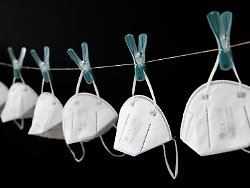Thursday February 11, 2021
New longing value remains vague
With an incidence of 35, there is a risk of opening up chaos
By Barbara Mauersberg
The new important seven-day incidence of 35 could be an incentive to reduce the number of new infections particularly drastically by March 7th. However, the handling of the longing brand after the federal-state summit is anything but clear. As with schools, there is a risk of a patchwork quilt.
After the lockdown in Germany was extended until March 7, the figure of 35 new infections per 100,000 inhabitants will be transformed into the new easing figure within a week. Only when this characteristic value has been reached in a stable manner should the first opening steps be decided. According to Chancellor Angela Merkel, "stable" means "three to five days" at the same level. However, the interpretation of this apparently clear brand after the federal-state summit is extremely ambiguous.
It is not yet clear how the federal states will implement this requirement. Are the shops, restaurants or museums allowed to reopen in individual counties as soon as the incidence falls steadily below 35? Or does the whole state have to stay below the 35 mark so that the first easing is allowed? At the request of ntv.de, the Federal Ministry of Health referred to the Federal Press Office. But that did not want to give any specific information. "The federal states will decide on the implementation of the opening steps when a stable 7-day incidence of 35 new infections per 100,000 inhabitants is reached," said a government spokeswoman. This also applies to the reference level, i.e. the question of whether districts or the entire country have to meet the easing conditions.
The start date of the gradual opening also remains vague. Do all countries or districts that remain under the brand start on March 7th? Or do additional days have to pass from the key date until the stability is stable enough? The federal government does not provide a Germany-wide timetable on this issue either. If all opening steps are in the hands of the countries, however, there is a risk of a loosening patchwork quilt with the stable 35, as is already causing frustration with the topic of school openings.
Avoid wild shopping trips
To make matters worse, the federal and state governments have to prevent shopping trips. When an area opens up, people from surrounding regions with higher incidence values should be avoided en masse. In a current Forsa survey by RTL and ntv, 42 percent of citizens already say that they would definitely or probably use shopping opportunities in a region that was opened earlier.
While the 35 mark still appears to be a target for many regions in Germany that is worth working towards, the number of districts that are already below the threshold is growing. In the districts of Dithmarschen (Schleswig-Holstein), Wilhelmshaven (Lower Saxony), Rotenburg Wümme (Lower Saxony), Verden (Lower Saxony), Münster (North Rhine-Westphalia), Zweibrücken (Rhineland-Palatinate) and Regensburg (Bavaria) the value is already below 20. The extension of the hard lockdown until March 7th should feel particularly tough there. In its answer to ntv.de, the federal government also leaves open whether these circles may relax earlier than March 7th. The next dispute of interpretation is thus programmed.
. (tagsToTranslate) Politics (t) Coronavirus Mutation (t) Lockdown
